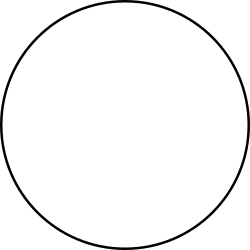Hilda family
The Hilda family (001[1]) is an ancient collisional asteroid family of at least 409 known asteroids,[2] named for its largest member, the 170-kilometre (110 mi)-across asteroid 153 Hilda. It lies within the larger dynamical group of Hilda asteroids, a group of asteroids in the 3:2 orbital resonance with Jupiter. All members of the family are dark P-type asteroids with albedos of around 0.06. Another asteroid family in the Hilda dynamical group is the Schubart family, named for its largest member, 1911 Schubart.
An asteroid family is a group of physically-related asteroids usually created by a collision with an original larger asteroid, with the fragments continuing on similar orbits to the original. This is distinct from a dynamical group in that the members of a dynamical group only share similar orbits because of gravitational interactions with planets, which concentrate asteroids in a particular orbital range. Members of the Hilda family are both part of the wider Hilda dynamical group, and fragments of 153 Hilda. The family is considered a non-catastrophic asteroid family because 153 Hilda, its largest member, makes up nearly 3/4 of the family's total mass, rather than simply being the largest of a number of fragments each making up a small fraction of the original destroyed asteroid.[3]
The family is believed to be one of the oldest collisional families ever discovered, with an estimated age of likely 4 billion years.[4][5] Models based on the modern Solar System indicate it being very unlikely for an asteroid as large as 153 Hilda to suffer a collision large enough to create its family, even over the course of billions of years of encounters with other asteroids, leading to a 2011 study to propose that the family-creating impact event happened during the Late Heavy Bombardment, when impact rates in the Solar System were briefly much higher.[6]
Large members
[edit]- 153 Hilda: 51.8 (71.4%)
- 1212 Francette: 3.97 (5.5%)
- 1746 Brouwer: 2.45 (3.4%)
- 1529 Oterma: 2.48 (3.4%)
- 3134 Kostinsky: 1.14 (1.6%)
- 1038 Tuckia: 0.969 (1.3%)
- 3990 Heimdal: 0.573 (0.8%)
- 4317 Garibaldi: 0.566 (0.8%)
- 3571 Milanstefanik: 0.423 (0.6%)
- 3561 Devine: 0.417 (0.6%)
- all other members: 7.74 (10.7%)
| Name | Abs. Mag | Size (km) | proper a (AU) |
proper e |
proper i |
|---|---|---|---|---|---|
| 153 Hilda | 7.8 | 171 | 3.9653 | 0.174 | 8.917 |
| 1212 Francette | 9.6 | 76 | 3.9674 | 0.230 | 7.237 |
| 1746 Brouwer | 10.0 | 63 | 3.9631 | 0.141 | 9.251 |
| 1529 Oterma | 10.0 | 56 | 3.9643 | 0.154 | 7.870 |
| 3134 Kostinsky | 10.5 | 50 | 3.9658 | 0.184 | 8.966 |
| 1038 Tuckia | 10.7 | 58 | 3.9648 | 0.164 | 8.239 |
| 3990 Heimdal | 11.0 | 36 | 3.9651 | 0.168 | 9.641 |
| 4317 Garibaldi | 11.1 | 39 | 3.9670 | 0.213 | 9.165 |
| 3571 Milanstefanik | 11.3 | 35 | 3.9620 | 0.127 | 9.210 |
| 3561 Devine | 11.3 | 33 | 3.9623 | 0.133 | 8.581 |
References
[edit]- ^ Nesvorny, D.; Broz, M.; Carruba, V. (2015). "Identification and Dynamical Properties of Asteroid Families". Asteroids IV. doi:10.48550/arXiv.1502.01628. Retrieved 28 July 2024.
- ^ a b Nesvorný, David (14 August 2020). "Nesvorny HCM Asteroid Families | PDS SBN Asteroid/Dust Subnode". NASA Planetary Data System. doi:10.26033/6cg5-pt13. Retrieved 28 July 2024.
- ^ Holsapple, K.A.; Housen, K.R. (December 2019). "The catastrophic disruptions of asteroids: History, features, new constraints and interpretations". Planetary and Space Science. 179: 104724. doi:10.1016/j.pss.2019.104724. Retrieved 30 July 2024.
- ^ Brož, M.; Vokrouhlický, D. (21 October 2008). "Asteroid families in the first-order resonances with Jupiter". Monthly Notices of the Royal Astronomical Society. 390 (2): 715–732. doi:10.1111/j.1365-2966.2008.13764.x. Retrieved 28 July 2024.
- ^ "Asteroid Family Ages". AstDyS. Retrieved 28 July 2024.
- ^ Brož, M.; Vokrouhlický, D.; Morbidelli, A.; Nesvorný, D.; Bottke, W. F. (2 May 2011). "Did the Hilda collisional family form during the late heavy bombardment?". Monthly Notices of the Royal Astronomical Society. 414 (3): 2716–2727. doi:10.1111/j.1365-2966.2011.18587.x. Retrieved 28 July 2024.

